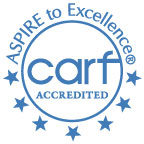Programs
 Supported Employment Client HandbookFor additional information on supported employment, please download our supported employment client handbook » |
Transition Partnership Program (TPP)
Also known as the school-to-work transition program, TPP offers the opportunity for students, prior to graduating from their special education program, to gain exposure to the world of work through Lincoln Training Center’s onsite classroom, and work-for-pay as they assimilate for brief periods of time in our production facility.
Habilitation
Habilitation services offer the opportunity to teach individuals with developmental disabilities basic work skills; assist them to develop their skills to meet industrial standards; and learn how to develop and maintain social relationships within a work environment. Services are provided through the team effort of our Production Supervisors and Rehabilitation Counselors. Each individual works for pay and receives holiday and vacation benefits.
VR-WAP

The Vocational Rehabilitation-Work Activity Program provides additional support to participants wishing to make the transition from our base-operated work services program into our community-based supported employment program.
VR-WAP is a time limited, systematic training program which assists persons in developing their optimal level of vocational development, utilizing real or simulated work in a facility (internal) or community based setting (external) with an emphasis on paid work. The intent of the program is to assist clients to understand the meaning, value, and demands of work; to learn or re-establish skills, attitudes, personal characteristics, and work behaviors; and to develop functional capacities leading towards a more independent level of employment. Activities in this program include, the development of: physical capacities, psychomotor skills, interpersonal and communicative skills, work behaviors and characteristics, job seeking and keeping skills, work performance skills, work-related functional skills, functional literary skills and knowledge of work practices. VR-WAP services are provided through 3 programs:
- External Situational Assessment (ESA):
External Situational Services (ESA) is a set of services specifically designed to assess a client’s current level of employability utilizing a variety of work environments. Clients will be able to identify their general areas of vocational interest, while increasing their knowledge of employment options available. An external assessment utilizes the community as an assessment tool, and the resulting report identifies barriers to employment and recommendations for services that will assist in removal of these barriers. Job Exploration may be a part of this program area. - Personal Vocational and Social Adjustment Services(PVSA):
Personal Vocational and Social Adjustment Services (PVSA) comprises a goal-oriented service in which functional skills are developed to enhance employability for a supported employment outcome or job maintenance in a group setting. This program is designed to maximize each person’s independent vocational functioning through the provision of training in appropriate work-related behaviors including grooming and hygiene, appropriate interaction in the workplace, communication, mobility and prevocational skills. Services are individually designed to eliminate identified barriers to employment and are generally an adjunct component of Community Employment or Work Services programs. - Job Exploration (JE):
Job Exploration is utilized to provide participants with a firsthand view of vocational opportunities within the community. Individuals are afforded the chance to observe various jobs and their related tasks to facilitate a thorough understanding of specific occupations. This program introduces many new jobs to our participants, and their exposure and observations serve as an excellent learning tool. Activities in this program include interviewing the participants to determine their area of interest within the work field and then transporting participants to designated job sites, as well as a variety of job sites perhaps not previously considered by the participant. Each job is then broken down into tasks, and participants receive a very clear and concise explanation regarding the job duties for each occupation.








